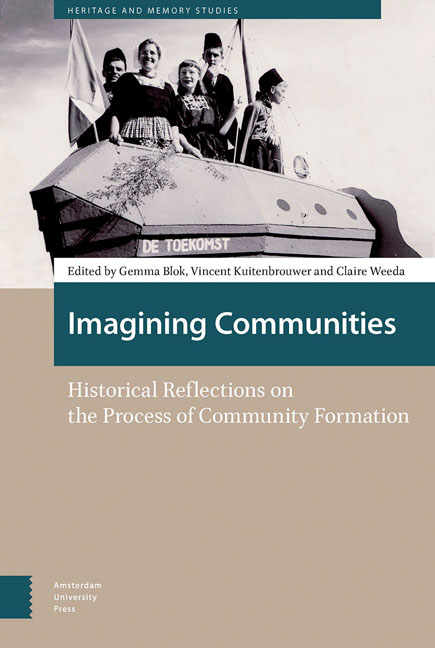Book contents
- Frontmatter
- Contents
- List of Figures
- Introduction
- 1 Meanwhile in Messianic Time: Imagining the Medieval Nation in Time and Space and English Drinking Rituals
- 2 Diverse Origins and Shared Circumstances: European Settler Identity Formation in the Seventeenth-Century Plantation Colony of Suriname
- 3 Imagining Europe: The Peace of Ryswick (1697) and the Rise of European Consciousness
- 4 Gypsy Music and the Fashioning of the National Community
- 5 ‘Tired, Worried and Overworked’: An International Imagined Community of Nervous Sufferers in Medical Advertisements, 1900-1920
- 6 ‘From Heart to Heart’: Colonial Radio and the Dutch Imagined Community in the 1920s
- 7 Indonesian Nationalism in the Netherlands, 1920s-1930s: Long-Distance Internationalism of Elite Pilgrims in Homogeneous, Empty Time
- 8 Time, Rhythm and Ritual: Imagined Communities in L’espoir (1937) and Les sept couleurs (1939)
- 9 Stamverwantschap and the Imagination of a White, Transnational Community: The 1952 Celebrations of the Jan van Riebeeck Tercentenary in the Netherlands and South Africa
- 10 ‘L’Oranie Cycliste, une grande famille’: Recycling Identities and the Pieds-Noirs Communitas, 1976-2016
- 11 Remembering and Imagining the National Past: Public Service Television Drama and the Construction of a Flemish Nation, 1953-1989
- Index
5 - ‘Tired, Worried and Overworked’: An International Imagined Community of Nervous Sufferers in Medical Advertisements, 1900-1920
Published online by Cambridge University Press: 11 December 2020
- Frontmatter
- Contents
- List of Figures
- Introduction
- 1 Meanwhile in Messianic Time: Imagining the Medieval Nation in Time and Space and English Drinking Rituals
- 2 Diverse Origins and Shared Circumstances: European Settler Identity Formation in the Seventeenth-Century Plantation Colony of Suriname
- 3 Imagining Europe: The Peace of Ryswick (1697) and the Rise of European Consciousness
- 4 Gypsy Music and the Fashioning of the National Community
- 5 ‘Tired, Worried and Overworked’: An International Imagined Community of Nervous Sufferers in Medical Advertisements, 1900-1920
- 6 ‘From Heart to Heart’: Colonial Radio and the Dutch Imagined Community in the 1920s
- 7 Indonesian Nationalism in the Netherlands, 1920s-1930s: Long-Distance Internationalism of Elite Pilgrims in Homogeneous, Empty Time
- 8 Time, Rhythm and Ritual: Imagined Communities in L’espoir (1937) and Les sept couleurs (1939)
- 9 Stamverwantschap and the Imagination of a White, Transnational Community: The 1952 Celebrations of the Jan van Riebeeck Tercentenary in the Netherlands and South Africa
- 10 ‘L’Oranie Cycliste, une grande famille’: Recycling Identities and the Pieds-Noirs Communitas, 1976-2016
- 11 Remembering and Imagining the National Past: Public Service Television Drama and the Construction of a Flemish Nation, 1953-1989
- Index
Summary
Abstract
Widely advertised around 1900, Pink Pills (patent medicines containing zinc or iron) were promoted to cure all kinds of ailments, including neurasthenia (‘weakness of the nerves’). The extensive advertisements portraying their consumers connected the ritual of daily pill taking to new psychiatric notions of ‘nervous fatigue’ as a legitimate modern condition. All over the world, newspaper readers were given the opportunity to identify with other ‘neurasthenics’: people they had never met, but who, like them, apparently struggled with the tensions and quick pace of modern life. Through reading newspapers and consuming Pink Pills, one could feel part of this imagined community. Thus, the patent medicine business was instrumental in the establishment of new psychiatric ways of thinking about oneself and the world.
Keywords: patent medicines, neurasthenia, history, newspaper advertisements, imagined community
In 1907, a Mr W.W. Munroe, of 16 Hazel Park, Everett, Massachusetts, was quoted in an advertising campaign in American local newspapers as saying he had become ‘ill from overwork’. While working as a foreman in a large manufacturing establishment in Boston, during a particularly hot summer where he was working in confined conditions, he started losing weight, strength and appetite. His memory started to fail him, he lost interest in life, and friends remarked on his abysmal condition. One of his friends recommended a possible remedy: Pink Pills, which ‘actually make new blood, and have cured such diseases as rheumatism, nervous and general debility, indigestion, and nervous headache’. The pills worked for Mr Munroe, he claimed. After several weeks, he had fully recovered.
Pink Pills, an originally Canadian product, were introduced in America and many other countries during the late nineteenth century. The pills were said to help against many ailments that were caused by ‘physical and mental exhaustion’, such as migraines, an upset stomach, anaemia and the psychiatric condition called neurasthenia (nervous weakness). They refreshed the blood and gave its users a rosy complexion, hence the name. In the first decades of the twentieth century, advertisements for Pink Pills were omnipresent in newspapers around the world. Many of the ads were journalist-style written reports on people who, like Mr Munroe, were greatly revitalized thanks to the Pink Pills. Taken together, I will argue, these ads created an international imagined community of nervous sufferers.
- Type
- Chapter
- Information
- Imagining CommunitiesHistorical Reflections on the Process of Community Formation, pp. 97 - 112Publisher: Amsterdam University PressPrint publication year: 2018

